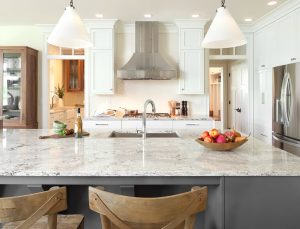This article is a comprehensive guide for individuals looking to design a kitchen that supports and nurtures their healthy eating goals. It explores the various elements of kitchen design, layout, and organization that contribute to a space where nutritious choices are not only encouraged but effortlessly integrated into daily life.
Introduction:
The kitchen is no longer just a place for meal preparation; it’s a sanctuary for nourishment and wellness. In this article, we embark on a journey to design a kitchen that seamlessly aligns with your healthy eating goals. Drawing from expert insights, we explore the essential elements that contribute to a kitchen space where wellness and culinary creativity flourish.
The Foundation of Wellness-Centric Design
Your kitchen’s layout and organization hold the key to fostering a healthy eating environment. A wellness-centric design prioritizes accessibility, functionality, and aesthetics. Consider an open layout that encourages movement and interaction, making it easy to access ingredients and utensils. Create designated zones for meal prep, cooking, and clean-up to streamline the cooking process. Thoughtful placement of countertops and storage ensures that nutritious choices are at your fingertips, making healthy eating an effortless part of your daily routine.

Mindful Storage Solutions for Nutrient-Packed Ingredients
Storage solutions play a vital role in supporting your healthy eating aspirations. Organize your pantry and cabinets with purpose, using transparent containers to display colorful fruits, vegetables, and grains. Dedicate shelves to specific food groups, allowing you to easily locate ingredients for balanced meals. Install pull-out racks and drawers for easy access to spices, herbs, and condiments. A well-organized refrigerator ensures that fresh produce remains visible and accessible, inspiring you to incorporate them into your meals.
The Power of Culinary Tools and Equipment
Equipping your kitchen with the right tools can make a world of difference in your healthy cooking endeavors. Invest in quality kitchen appliances that facilitate nutrient-rich meal preparation. A blender or food processor can effortlessly transform fruits and vegetables into smoothies or sauces. Non-stick cookware reduces the need for excessive oil, promoting healthier cooking methods. Sharp knives and cutting boards encourage efficient chopping of vegetables and fruits. By choosing purposeful culinary tools, you empower yourself to create wholesome meals with ease.
Aesthetic Choices that Inspire Wholesome Cooking
The visual and sensory elements of your kitchen have a profound impact on your eating experience. Opt for a color palette that evokes a sense of freshness and vitality. Incorporate natural light by placing workstations near windows or using light-colored finishes that reflect illumination. Consider adding indoor plants to your kitchen space, not only for aesthetics but also to purify the air and create a calming environment. Soft, ambient lighting can create a cozy atmosphere that encourages mindful eating and relaxation.
Conclusion:
Designing a kitchen that nurtures your healthy eating goals is an investment in your well-being. By incorporating principles of wellness-centric design, mindful storage solutions, purposeful culinary tools, and inspiring aesthetics, you create a space where every meal becomes an opportunity to nourish both your body and soul. As you embark on this journey of kitchen transformation, remember that each design choice brings you closer to a healthier, more vibrant lifestyle—a lifestyle that begins in the heart of your home.










